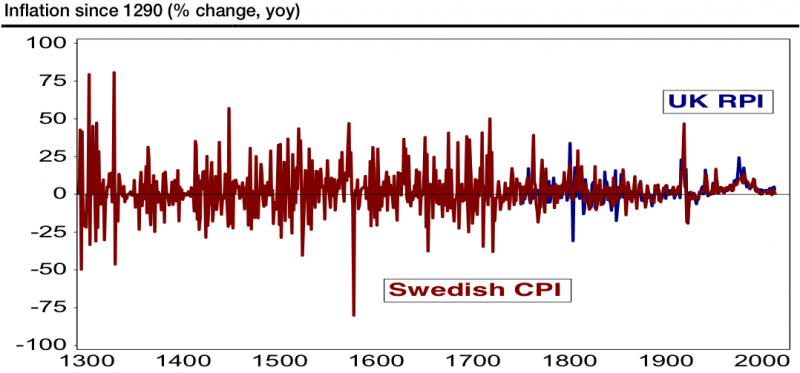
Wall St Analyst Crams 700 Years Of Data Into Bearish Call On US Stocks
“The starting point of any financial analysis must surely be a consideration of the economic cycle: not just where we stand within the current cycle, but more importantly, where that cycle fits within broader economic history,” writes Paul Jackson in his final note to clients in his role as an equity strategist at Société Générale.
The note — titled “Swan song: 12 pictures you can’t ignore” — builds on the bank’s recent call for clients to rotate out of U.S. stocks and into European stocks. The SocGen asset allocation team predicts the S&P 500 will fall by around 15% when the Federal Reserve winds down its quantitative easing program, then go nowhere for years.
“For now, equity valuations in Europe are attractive and with a bit of economic growth the next few years could be quite rewarding,” says Jackson. “The immediate risks are that growth does not materialise in Europe or that the eurozone project unravels. For the longer term I worry more about latent inflation risks and central banks getting behind the curve. As bond markets react to that policy error, the folly of forcing banks, insurance companies and pension funds to hold so many bonds will become apparent. But that is for another day.”
1. Current inflation trends are boringly normal.

“Inflation may feel low compared to the history through which most of us have lived, but in a broader context it is boringly normal,” says Jackson. “Maybe without recent extra-ordinary policy settings, we would now be experiencing deflation, but we will never really know.”
…read and view much more HERE
2. Inflation has little effect on stock market valuation.
3. History suggests low returns ahead for U.S. stocks.
4. U.S. companies may be in for disappointment.
5. Europe’s economy has room to improve.
6. A better European economy means better European profits.
7. European stocks look attractive.
8. Many metrics suggest Europe is undervalued.
9. The real bubble is in the bond market.
10. The ECB’s balance sheet has been shrinking for a while.
11. The euro is getting a boost from ECB inaction.
12. The question is what happens when the Fed pulls back.












